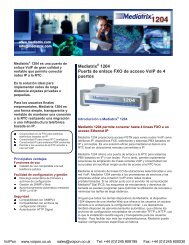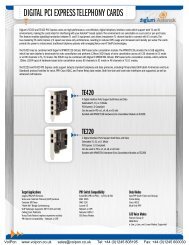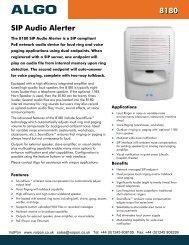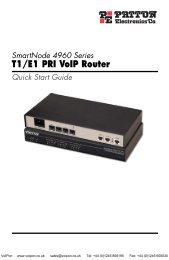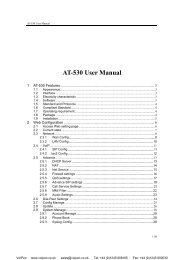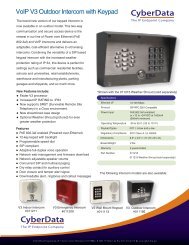Grandstream Handytone 486 User Manual (PDF) - VoIPon Solutions
Grandstream Handytone 486 User Manual (PDF) - VoIPon Solutions
Grandstream Handytone 486 User Manual (PDF) - VoIPon Solutions
Create successful ePaper yourself
Turn your PDF publications into a flip-book with our unique Google optimized e-Paper software.
<strong>User</strong> <strong>Manual</strong>HandyTone-<strong>486</strong>Analog Telephone AdaptorFor Firmware Version 1.0.8.32<strong>Grandstream</strong> Networks, Inc.www.grandstream.com<strong>VoIPon</strong> www.voipon.co.uk sales@voipon.co.uk Tel: +44 (0)1245 808195 Fax: +44 (0)1245 600030
HandyTone-<strong>486</strong> <strong>User</strong> <strong>Manual</strong><strong>Grandstream</strong> Networks, Inc.6.2.4 Saving the Configuration Changes.................................................................... 356.2.5 Rebooting the HandyTone-<strong>486</strong> from remote ..................................................... 366.3 CONFIGURATION THROUGH A CENTRAL SERVER....................................................... 367 SOFTWARE UPGRADE............................................................................................. 377.1 FIRMWARE UPGRADE THROUGH TFTP/HTTP........................................................... 377.2 CONFIGURATION FILE DOWNLOAD ........................................................................... 387.3 FIRMWARE AND CONFIGURATION FILE PREFIX AND POSTFIX.................................... 387.4 MANAGING FIRMWARE AND CONFIGURATION FILE DOWNLOAD .............................. 388 RESTORE FACTORY DEFAULT SETTING.......................................................... 399 GLOSSARY OF TERMS............................................................................................. 403<strong>VoIPon</strong> www.voipon.co.uk sales@voipon.co.uk Tel: +44 (0)1245 808195 Fax: +44 (0)1245 600030
HandyTone-<strong>486</strong> <strong>User</strong> <strong>Manual</strong><strong>Grandstream</strong> Networks, Inc.1 WelcomeCongratulations on becoming an owner of HandyTone-<strong>486</strong>. You made an excellent choice and wehope you will enjoy all its capabilities.<strong>Grandstream</strong>'s award-wining HandyTone-<strong>486</strong> is an all-in-one VoIP integrated access device thatfeatures superb audio quality, rich functionalities, high level of integration, compactness and ultraaffordability.The HandyTone-<strong>486</strong> is fully compatible with SIP industry standard and can interoperatewith many other SIP compliant devices and software on the market.<strong>Grandstream</strong> HandyTone-<strong>486</strong> has been awarded the Best of Show product in 2004 Internet TelephonyConference and Expo.This document is subject to changes without notice. The latest electronic version of this user manualcan be downloaded from the following location:http://www.grandstream.com/user_manuals/HandyTone-<strong>486</strong><strong>User</strong><strong>Manual</strong>.pdf4<strong>VoIPon</strong> www.voipon.co.uk sales@voipon.co.uk Tel: +44 (0)1245 808195 Fax: +44 (0)1245 600030
HandyTone-<strong>486</strong> <strong>User</strong> <strong>Manual</strong><strong>Grandstream</strong> Networks, Inc.2 InstallationHandyTone-<strong>486</strong> Analog Telephone Adaptor is an all-in-one VoIP integrated device designed to be atotal solution for networks providing VoIP services.The HandyTone-<strong>486</strong> VoIP functionalities are available via a regular analog telephone.The following photo illustrates the appearance of a HandyTone-<strong>486</strong>.Top ViewSide ViewsRJ11Telephone(Phone)RJ4510M EthernetLAN - WAN+5V/1200mABUTTONRED LEDGREEN LEDRJ11Phone Line(Line)Interconnection Diagram of the HandyTone-<strong>486</strong>:Internet ADSL/CableModem EthernetAnalog PhoneWANPSTNLINEPHONECordless PhoneLANPCPCPCFax5<strong>VoIPon</strong> www.voipon.co.uk sales@voipon.co.uk Tel: +44 (0)1245 808195 Fax: +44 (0)1245 600030
HandyTone-<strong>486</strong> <strong>User</strong> <strong>Manual</strong><strong>Grandstream</strong> Networks, Inc.Following are the steps to install a HandyTone-<strong>486</strong>:1. Connect a standard touch-tone analog telephone (or fax machine) to PHONE port.2. Connect a PSTN telephone line to LINE port (optional).3. Insert the Ethernet cable into the WAN port of HandyTone-<strong>486</strong> and connect the other end ofthe Ethernet cable to an uplink port (a router or a modem, etc.)4. Connect a PC to the LAN port of HandyTone-<strong>486</strong>.5. Insert the power adapter into the HandyTone-<strong>486</strong> and connect it to a wall outlet.Please follow the instructions in section 6.2.1 to configure the HandyTone-<strong>486</strong>.6<strong>VoIPon</strong> www.voipon.co.uk sales@voipon.co.uk Tel: +44 (0)1245 808195 Fax: +44 (0)1245 600030
HandyTone-<strong>486</strong> <strong>User</strong> <strong>Manual</strong><strong>Grandstream</strong> Networks, Inc.4 Product Overview4.1 Key Features• Supports SIP 2.0(RFC 3261), TCP/UDP/IP, RTP/RTCP, HTTP, ICMP, ARP/RARP, DNS,DHCP (both client and server), NTP, PPPoE, STUN, TFTP, etc.• Built-in router, NAT, Gateway and DMZ port forwarding. Can also be configured to functionas a two Ethernet ports bridge (NAT function is disabled)• Device bridge mode support• Powerful digital signal processing (DSP) to ensure superb audio quality; advanced adaptivejitter control and packet loss concealment technology• Support various codecs including G.711 (PCM a-law and u-law), G.723.1 (5.3K/6.3K), G.726(32K), as well as G.729A and iLBC• Support Caller ID/name display or block, Call waiting caller ID, Hold, Call Waiting/Flash, CallTransfer, 3-way conference (on Rev. 2.0), Call Forward, in-band and out-of-band DTMF, etc.• Support fax pass through (via PCMU or PCMA) and T.38 FoIP (Fax over IP)• Support Silence Suppression, VAD (Voice Activity Detection), CNG (Comfort NoiseGeneration), Line Echo Cancellation (G.168), and AGC (Automatic Gain Control)• Support standard encryption and authentication (DIGEST using MD5 and MD5-sess)• Support for Layer 2 (802.1Q VLAN, 802.1p) and Layer 3 QoS (ToS, DiffServ, MPLS)• Support automated NAT traversal without manual manipulation of firewall/NAT• Support device configuration via built-in IVR, Web browser or encrypted configuration filesthrough TFTP or HTTP server• Support firmware upgrade via TFTP or HTTP• Support PSTN pass through (on Rev.2.0)• Support SIP Session Timer• Support Syslog (on Rev.2.0)• Support volume amplification• Support configurable Call Progress Tones• Ultra compact (wallet size) and lightweight design, great companion for travelers• Compact, lightweight Universal Power adapter8<strong>VoIPon</strong> www.voipon.co.uk sales@voipon.co.uk Tel: +44 (0)1245 808195 Fax: +44 (0)1245 600030
HandyTone-<strong>486</strong> <strong>User</strong> <strong>Manual</strong><strong>Grandstream</strong> Networks, Inc.4.2 Hardware SpecificationThe table below lists the hardware specification of HandyTone-<strong>486</strong>.ModelHandyTone-<strong>486</strong>LAN interface1xRJ45 10Base-TWAN interface1xRJ45 10Base-TFXS telephone port 1xFXSPSTN port1x PSTN pass through or life line portButton 1LEDGreen and red colorUniversal SwitchingPower AdaptorInput: 100-240VAC 50-60 HzOutput: +5VDC, 1200mA,UL certifiedDimension70mm (W)130mm (D)27mm (H)Weight0.6lbs (0.3kg)Temperature40 - 130 o F5 – 45 o CHumidity 10% - 90%(non-condensing)ComplianceNOTE:• HandyTone-<strong>486</strong> has two hardware revisions. This information can be found on the label at thebottom of the device. The difference between HandyTone-<strong>486</strong> Rev.1.0 and HandyTone-<strong>486</strong>Rev.2.0 is that a HandyTone-<strong>486</strong> Rev.2.0 line port can function as PSTN pass through while aHandyTone-<strong>486</strong> (Rev.1.0, old model, no longer shipped) line port is just a life line port and willbridge to PSTN only when the device is out of power.9<strong>VoIPon</strong> www.voipon.co.uk sales@voipon.co.uk Tel: +44 (0)1245 808195 Fax: +44 (0)1245 600030
HandyTone-<strong>486</strong> <strong>User</strong> <strong>Manual</strong><strong>Grandstream</strong> Networks, Inc.5 Basic Operations5.1 Get Familiar with Key Pad and Voice PromptHandyTone-<strong>486</strong> stores a voice prompt menu (Interactive Voice Response or IVR) for quick browsingand simple configuration. To enter this voice prompt menu, simply press the button on theHandyTone-<strong>486</strong> or pick up the phone and dial “***”. The following table shows how to use the voiceprompt menu to configure the device.Menu Voice Prompt <strong>User</strong>’s OptionsMain Menu “Enter a Menu Option” Enter “*” for the next menu optionEnter “#” to return to the main menuEnter 01 – 06, 47, 86 or 99 Menu option01 “DHCP Mode”, or“Static IP Mode”10Enter ‘9’ to toggle the selectionIf user selects “Static IP Mode”, user needconfigure all the IP address informationthrough menu 02 to 05. If user selects“Dynamic IP Mode”, the device will retrieveall IP address information from DHCP serverautomatically when user reboots the device.02 “IP Address “ + IP address The current WAN IP address is announcedEnter 12-digit new IP address if in Static IPMode.03 “Subnet “ + IP address Same as Menu option 0204 “Gateway “ + IP address Same as Menu option 0205 “DNS Server “ + IP address Same as Menu option 0207 Preferred Vocoder Enter “9” to go to the next selection in the list:- PCM U- PCM A- G-723- G-729- iLBC- G-72612 WAN Port Web Access Enter “9” to toggle between:- enable- disable13 Firmware Server IP Address The current Firmware Server IP address isannounced. Enter 12 digit new IP address.14 Configuration Server IPAddressThe current Config Server Path IP address isannounced. Enter 12 digit new IP address.15 Upgrade Protocol Upgrade protocol for firmware andconfiguration update. Enter “9” to togglebetween:- TFTP- HTTP<strong>VoIPon</strong> www.voipon.co.uk sales@voipon.co.uk Tel: +44 (0)1245 808195 Fax: +44 (0)1245 600030
HandyTone-<strong>486</strong> <strong>User</strong> <strong>Manual</strong><strong>Grandstream</strong> Networks, Inc.16 Firmware Version Firmware version information.17 Firmware Upgrade Firmware upgrade mode. Enter “9” to rotateamong the following three options:- always check- check when pre/suffix changes- never upgrade47 “Direct IP Calling” When entered, user will be prompted a dialtone, dial a 12-digit IP address to make a directIP call.(For details, see “4.2.2 Make a Direct IPCall”.)99 “RESET” Enter “9” to reboot the device; orEnter MAC address to restore factory defaultsetting (For details, see section 8.)“Invalid Entry”Automatically returns to Main MenuNOTES:• Once the LED button is pressed, it enters voice prompt main menu. If the button is pressedagain while it is already in the voice prompt menu state, it jumps to “Direct IP Calling” optionand dial tone plays in this state• “*” shifts down to the next menu option• “#” returns to the main menu• “9” functions as the ENTER key in many cases to confirm an option• All entered digit sequences have known lengths - 2 digits for menu option and 12 digits for IPaddress. Once all digits are accumulated, the device will automatically process them• For IP address input, omit the dot and enter the digits directly, add 0 for those octets with lessthan three digits. e.g.: IP: 192.168.1.10, key in: 192168001010• Key entry cannot be deleted but the phone may prompt error once it is detected5.2 Make Phone Calls5.2.1 Calling phone or extension numbersThere are currently two methods to make an extension number call:a) Dial the numbers directly and wait for 4 seconds (Default “No Key Entry Timeout”). Orb) Dial the numbers directly, and press # (assuming that “use #” as dial key is selected in webconfiguration).Examples:To dial another extension on the same proxy, such as 1008, simply pick up attached phone, dial1008 and then press the # or wait for 4 seconds.To dial a PSTN number such as 6266667890, you might need to enter in some prefix numberfollowed by the phone number. Please check with your VoIP service provider to get the information. Ifyou phone is assigned with a PSTN-like number such as 6265556789, most likely you just follow the11<strong>VoIPon</strong> www.voipon.co.uk sales@voipon.co.uk Tel: +44 (0)1245 808195 Fax: +44 (0)1245 600030
HandyTone-<strong>486</strong> <strong>User</strong> <strong>Manual</strong><strong>Grandstream</strong> Networks, Inc.rule to dial 16266667890 as if you were calling from a regular analog phone, followed by pressing the# or wait for 4 seconds.5.2.2 Direct IP callsDirect IP calling allows two parties, that is, a HandyTone with an analog phone and another VoIPDevice, to talk to each other in an ad hoc fashion without a SIP proxy. This kind of VoIP calls can bemade between two parties if:• Both HandyTone ATA and other VoIP Device(i.e., another HandyTone ATA or Budgetone SIPphone or other VoIP unit) have public IP addresses, or• Both HandyTone ATA and other VoIP Device are on the same LAN using private IP addresses,or• Both HandyTone ATA and other VoIP Device can be connected through a router using publicor private IP addresses (with necessary port forwarding or DMZ).To make a direct IP to IP call, first pick up the analog phone or turn on the speakerphone on the analogphone, then access the voice menu prompt by dial “***” or press the button on the HandyTone-286,and dials “47” to access the direct IP call menu. <strong>User</strong> will hear a voice prompt “Direct IP Calling” anda dial tone. Enter a 12-digit target IP address to make a call. Destination ports can be specified byusing “*4” (encoding for “:”) followed by the port number.Examples:If the target IP address is 192.168.0.10, the dialing convention isVoice Prompt with option 47, then 192 168 000 010followed by pressing the “#” key if it is configured as a send key or wait for more than 5 seconds.If the target IP address/port is 192.168.1.20:5062, then the dialing convention would be:Voice Prompt with option 47, then 192168001020*45062 followed by pressing the “#” key if it isconfigured as a send key or wait for 4 seconds.5.2.3 Call HoldWhile in conversation, pressing the “FLASH” button on the attached phone will put the remote end onhold. Pressing the “FLASH” button again will release the previously Hold party and the bi-directionalmedia will resume.5.2.4 Call WaitingIf call waiting feature is enabled, while the user is in a conversation, he will hear a special stutter toneif there is another incoming call. <strong>User</strong> can press the flash button to put the current call party on holdand switch to the other call. Pressing flash button toggles between two active calls.12<strong>VoIPon</strong> www.voipon.co.uk sales@voipon.co.uk Tel: +44 (0)1245 808195 Fax: +44 (0)1245 600030
HandyTone-<strong>486</strong> <strong>User</strong> <strong>Manual</strong><strong>Grandstream</strong> Networks, Inc.5.2.5 Call Transfer5.2.5.1 Blind TransferAssuming that call party A and B are in conversation. A wants to Blind Transfer B to C:1. A presses “FLASH” on the analog phone ( or Hook Flash for old model phones) to get a dialtone.2. A dials *87 followed by C’s number, then #(or wait for 4 seconds)3. A can hang up.NOTE: “Enable Call Feature” has to be set to “Yes” in web configuration page.A can hold on to the phone and wait for one of the three following behaviors:• A quick confirmation tone (temporarily using the call waiting indication tone) followed by adial tone. This indicates the transfer is successful (transferee has received a 200 OK fromtransfer target). At this point, A can either hang up or make another call.• A quick busy tone followed by a restored call (on supported platforms only). This means thetransferee has received a 4xx response for the INVITE and we will try to recover the call. Thebusy tone is just to indicate to the transferor that the transfer has failed.• Busy tone keeps playing. This means we have failed to receive the second NOTIFY from thetransferee and decided to time out. Note: this does not indicate the transfer has beensuccessful, nor does it indicate the transfer has failed. When transferee is a client that does notsupport the second NOTIFY (such as our own earlier firmware), this will be the case. In badnetwork scenarios, this could also happen, although the transfer may have been completedsuccessfully.5.2.5.2 Attended TransferAssuming that call party A and B are in conversation. A wants to Attend Transfer B to C:1. A presses “FLASH” on the analog phone (or Hook Flash for old model phones) to get a dialtone2. A then dial C’s number followed by # (or wait for 4 seconds).3. If C answers the call, A and C are in conversation. Then A can hang up to complete transfer.4. If C does not answer the call, A can press “FLASH” back to talk to B.NOTE:• When Attended Transfer failed and A hang up, HandyTone- <strong>486</strong> will ring user A back again toremind A that B is still on the call. A can pick up the phone to restore conversation with B.13<strong>VoIPon</strong> www.voipon.co.uk sales@voipon.co.uk Tel: +44 (0)1245 808195 Fax: +44 (0)1245 600030
HandyTone-<strong>486</strong> <strong>User</strong> <strong>Manual</strong><strong>Grandstream</strong> Networks, Inc.5.2.6 3-way ConferencingHandyTone-496 supports 3-way conference in two styles: star code style or Bellcore style.5.2.6.1 Star Code Style 3-way ConferenceAssuming that call party A and B are in conversation. A wants to bring C in a conference:1. A presses FLASH (on the analog phone, or Hook Flash for old model phones) to get a dialtone.2. A dials *23 then C’s number then # (or wait for 4 seconds).3. If C answers the call, then A press “flash” to bring B, C in the conference.4. If C does not answer the call, A can press “flash” back to talk to B.5.2.6.2 Bellcore Style 3-way ConferenceBellcore style 3-way conference is also supported. To do this, user needs to enable “Use Bell-style 3-way Conference” in FXS1 or FXS2 web configuration.Assuming that call party A and B are in conversation. A wants to bring C in a conference:1. A presses FLASH (on the analog phone, or Hook Flash for old model phones) to get a dialtone.2. A dials C’s number then # (or wait for 4 seconds).3. If C answers the call, then A press “flash” to bring B, C in the conference.4. If C does not answer the call, A can press “flash” back to talk to B.5.2.7 PSTN Pass Through/Life lineHandyTone-<strong>486</strong> Rev. 2.0 supports PSTN pass through. <strong>User</strong> can send and receive PSTN calls with theattached analog phone.To receive PSTN calls, simply make phone off hook when the analog phone rings.To make a PSTN call, press the PSTN access code (*00 by default, or any number configured in webconfiguration page) to switch to PSTN line and get a dial tone, then dial the PSTN number.When HandyTone-<strong>486</strong> is out of power, it will function as a jack. <strong>User</strong> can use the same analog phonefor PSTN calls.5.3 Call Features5.3.1 Call Features Table (star code)Following table shows the call features (* code) of HandyTone-<strong>486</strong>.14<strong>VoIPon</strong> www.voipon.co.uk sales@voipon.co.uk Tel: +44 (0)1245 808195 Fax: +44 (0)1245 600030
HandyTone-<strong>486</strong> <strong>User</strong> <strong>Manual</strong><strong>Grandstream</strong> Networks, Inc.5.4 FAXKey Call Features*23 3-way conference*87 Blind Transfer*30 Block CallerID (for all-config change)*31 Send CallerID (for all-config change)*67 Block CallerID (per call)*82 Send CallerID (per call)*50 Disable Call Waiting (for all-config change)*51 Enable Call Waiting (for all-config change)*70 Disable Call Waiting. (Per Call)*71 Enable Call Waiting (Per Call)*72 Unconditional Call Forward.To use this feature, dial “*72”, wait for the dial tone. Then dialthe forward number ended with #, wait for dial tone, hang up.*73 Cancel Unconditional Call ForwardTo cancel “Unconditional Call Forward”, dial “*73” and get thedial tone, then hang up.*90 Busy Call ForwardTo use this feature, dial “*90”, wait for the dial tone. Then dialthe forward number ended with #, wait for dial tone, hang up.*91 Cancel Busy Call ForwardTo cancel “Busy Call Forward”, dial “*91” and get the dialtone, then hang up*92 Delayed Call ForwardTo use this feature, dial “*92”, wait for the dial tone. Then dialthe forward number ended with #, wait for dial tone, hang up.*93 Cancel Delayed Call ForwardTo cancel this Forward, dial “*93” and get the dial tone, thenhang upFlash/Hook When in conversation, this action will switch to the newincoming call if user heard the call waiting sound.When in conversation and no incoming call heard, this actionwill switch to a new channel for a new call.HandyTone-<strong>486</strong> supports FAX in two modes: T.38 (Fax over IP) and fax pass through. T.38 is thepreferred method because it is more reliable and works well in most network conditions. If the serviceprovider supports T.38, please use this method by selecting Fax mode to be T.38. If the serviceprovider does not support T.38, pass-through mode may be used. To send or receive faxes in fax passthrough mode, users will need to select all the Preferred Codecs to be PCMU/PCMA.15<strong>VoIPon</strong> www.voipon.co.uk sales@voipon.co.uk Tel: +44 (0)1245 808195 Fax: +44 (0)1245 600030
HandyTone-<strong>486</strong> <strong>User</strong> <strong>Manual</strong><strong>Grandstream</strong> Networks, Inc.5.5 LED Light Pattern IndicationFollowing are the LED light pattern indications.RED LED always indicates not abnormal statusDHCP Failed or WAN No Cable Button flashes every 2 seconds (if DHCP is configured)HandyTone-<strong>486</strong> fails to register Button flashes every 2 seconds (if SIP server is configured)Firmware UpgradingButton flashes every 2 secondsDevice MalfunctionsRed light steady onGREEN LED mostly indicates normal working statusMessage Waiting IndicationButton flashes every 2 secondsRINGINGButton flashes at 1/10 secondRINGING INTERVALButton flashes every secondIn ConversationGreen light steady on16<strong>VoIPon</strong> www.voipon.co.uk sales@voipon.co.uk Tel: +44 (0)1245 808195 Fax: +44 (0)1245 600030
HandyTone-<strong>486</strong> <strong>User</strong> <strong>Manual</strong><strong>Grandstream</strong> Networks, Inc.6 Configuration Guide6.1 Configuring HandyTone-<strong>486</strong> through Voice Prompt6.1.1 DHCP ModeFollow section 5.1 with voice menu option 01 to enable HandyTone-<strong>486</strong> to use DHCP.6.1.2 STATIC IP ModeFollow section 5.1 with voice menu option 01 to enable HandyTone-<strong>486</strong> to use STATIC IP mode, thenuse option 02, 03, 04, 05 to set up IP address, Subnet Mask, Gateway, and DNS server respectively.6.1.3 Firmware Server IP AddressFollow section 5.1 with voice menu option 13 to configure the IP address of the firmware server.6.1.4 Configuration Server IP AddressFollow section 5.1 with voice menu option 14 to configure the IP address of the configuration server.6.1.5 Upgrade ProtocolFollow section 5.1 with voice menu option 15 to choose firmware and configuration upgrade protocol.<strong>User</strong> can choose between TFTP and HTTP.6.1.6 Firmware Upgrade ModeFollow section 5.1 with voice menu option 17 to choose firmware upgrade mode among the followingthree options:- always check- check when pre/suffix changes- never upgrade6.1.7 WAN Port Web AccessFollow section 5.1 with voice menu option 12 to enable WAN Port Wed Access of the deviceconfiguration pages.17<strong>VoIPon</strong> www.voipon.co.uk sales@voipon.co.uk Tel: +44 (0)1245 808195 Fax: +44 (0)1245 600030
HandyTone-<strong>486</strong> <strong>User</strong> <strong>Manual</strong><strong>Grandstream</strong> Networks, Inc.6.2 Configuring HandyTone-<strong>486</strong> with Web BrowserHandyTone-<strong>486</strong> has an embedded Web server that will respond to HTTP GET/POST requests. It alsohas embedded HTML pages that allow a user to configure the HandyTone-<strong>486</strong> through a Web browsersuch as Microsoft’s IE and AOL’s Netscape.6.2.1 Access the Web Configuration MenuHandyTone-<strong>486</strong>’s web configuration page can be accessed via LAN or WAN port:• From the LAN port:• Directly connect a computer to the LAN port.• Open a command window on the computer• Type in “ipconfig /release”, the IP address etc. become 0.0.0.0.• Type in “ipconfig /renew”, the computer gets an IP address in 192.168.2.1 by default• Open a web browser, type in the default gateway IP address. You will see the loginpage of the device.• From the WAN port:http://192.168.2.1The WAN port HTML configuration option is disabled by default from factory. To access theHTML configuration menu from the WAN port, first enable the “WAN side HTTP access” optionvia IVR option 12. With the WAN side HTTP access enabled, then get the WAN IP address of theHandyTone-<strong>486</strong> through section 5.1 with menu option 02. The HandyTone-<strong>486</strong>’s WebConfiguration page can be accessed by the following URI via WAN port:NOTE:http://HandyTone-IP-Addresswhere the HandyTone-IP-Address is the WAN IP address of the HandyTone-<strong>486</strong>.• To type IP address into browser to get into the configuration page, please strip out the leading“0”s as the browser will parse in octet. e.g.: if the IP address is: 192.168.001.014, please typein: 192.168.1.14.6.2.2 End <strong>User</strong> ConfigurationOnce this request is entered and sent from a Web browser, the HandyTone-<strong>486</strong> will respond with thefollowing login screen:18<strong>VoIPon</strong> www.voipon.co.uk sales@voipon.co.uk Tel: +44 (0)1245 808195 Fax: +44 (0)1245 600030
HandyTone-<strong>486</strong> <strong>User</strong> <strong>Manual</strong><strong>Grandstream</strong> Networks, Inc.<strong>Grandstream</strong> Device ConfigurationPasswordLoginAll Rights Reserved <strong>Grandstream</strong> Networks, Inc. 2005The password is case sensitive with a maximum length of 25 characters. The factory default passwordfor End <strong>User</strong> and administrator is “123” and “admin” respectively. Only administrator can get accessto “ADVANCED SETTINGS” configuration page.NOTE:• If you can not log into the configuration page by using the default password, please check withyour VoIP service provider. Most likely, the service provider has provisioned the device andconfigured for you and changed the default password.After the correct password is entered into the login screen, the embedded Web server inside the devicewill respond with the following BASIC SETTINGS configuration page:End <strong>User</strong>Password:Web Port: 80IP Address:<strong>Grandstream</strong> Device ConfigurationSTATUS BASIC SETTINGS ADVANCED SETTINGS(default for HTTP is 80)(purposely not displayed for security protection)dynamically assigned via DHCP (default) or PPPoE(will attempt PPPoE if DHCP fails and following is non-blank)DHCP hostname:DHCP domain:DHCP vendor class ID:PPPoE account ID:PPPoE password:Preferred DNS server:0.0.0.0statically configured as:19<strong>VoIPon</strong> www.voipon.co.uk sales@voipon.co.uk Tel: +44 (0)1245 808195 Fax: +44 (0)1245 600030
HandyTone-<strong>486</strong> <strong>User</strong> <strong>Manual</strong><strong>Grandstream</strong> Networks, Inc.IP Address: 192 168 1 160. . .Subnet Mask: 255 255 255 0. . .Default Router: 192 .168 .1.1DNS Server 1: 192 .168 .1.1DNS Server 2: 0.0.0.0Time Zone:GMT-5:00 (US Eastern Time, New York)DaylightSavings Time: No Yes Optional Rule:4,1,7,2,0;10,-1,7,2,0;60PSTN AccessCode: (key pattern to use the PSTN line, default is "*00")NAT/Bridge/DHCP Server Information & Configuration:Device Mode:NAT RouterBridgeWAN Side HTTPAccess: No Yes (WAN side access to http server will be rejected if set to No)Reply to ICMPon WAN port: No Yes (Unit will not respond to PING from WAN side if set to No)Cloned WANMAC Addr:LAN SubnetMask:LAN DHCP BaseIP:DHCP IP LeaseTime:DMZ IP:255.255.255.0192.168.2.1120(in hex format)(default is 255.255.255.0)(base IP for the LAN port, default is 192.168.2.1)(in units of hours, default is 120 hours or 5 days)PortForwarding:WAN portWAN portWAN portWAN portWAN portWAN portWAN portWAN port00000000LAN IP LAN portLAN IP LAN portLAN IP LAN portLAN IP LAN portLAN IP LAN portLAN IP LAN portLAN IP LAN portLAN IP LAN port00000000ProtocolProtocolProtocolProtocolProtocolProtocolProtocolProtocolUDP OnlyUDP OnlyUDP OnlyUDP OnlyUDP OnlyUDP OnlyUDP OnlyUDP OnlyUpdate Cancel RebootAll Rights Reserved <strong>Grandstream</strong> Networks, Inc. 200520<strong>VoIPon</strong> www.voipon.co.uk sales@voipon.co.uk Tel: +44 (0)1245 808195 Fax: +44 (0)1245 600030
HandyTone-<strong>486</strong> <strong>User</strong> <strong>Manual</strong><strong>Grandstream</strong> Networks, Inc.End <strong>User</strong>PasswordThis field contains the password to access the Web Configuration Menu. Thepassword is case sensitive with a maximum of 25 characters.Web Port This is the device’s internal HTTP server port. Default is 80.IP AddressThere are 2 modes under which the HandyTone ATA can operate:- If DHCP mode is enabled, then all the field values for the Static IP mode arenot used (even though they are still saved in the Flash memory) and the IPphone will acquire its IP address from the first DHCP server it discovers onthe LAN it attaches to.To use PPPoE feature please set the PPPoE account settings if the HandyToneATA is connected directly to a DSL modem. The HandyTone ATA willattempt to establish a PPPoE session if any of the PPPoE fields are set.- If Static IP mode is selected, then the IP address, Subnet Mask, DefaultRouter IP address, DNS Server 1 (primary), DNS Server 2 (secondary) fieldswill need to be configured. These fields are set to zero by default.DHCP hostnameDHCP domainDHCP vendor classIDPPPoE account IDPPPoE passwordTime ZoneThis option specifies the name of the client. This field is optional but may berequired by some Internet Service Providers. Default is blank.This option specifies the domain name that client should use when resolvinghostnames via the Domain Name System. Default is blank.This option is used by clients and servers to exchange vendor-specificinformation. Default is blank.PPPoE username. Fill this field if your ISP requires you to use a PPPoE(Point to Point Protocol over Ethernet) connection.PPPoE account password.This parameters decides how the displayed date/time will be adjustedaccording to the specified time zone.21<strong>VoIPon</strong> www.voipon.co.uk sales@voipon.co.uk Tel: +44 (0)1245 808195 Fax: +44 (0)1245 600030
HandyTone-<strong>486</strong> <strong>User</strong> <strong>Manual</strong><strong>Grandstream</strong> Networks, Inc.Daylight SavingsTimeThis parameter controls whether the displayed time will be daylight savingstime or not. If set to “Yes” and the Optional Rule is empty, then the displayedtime will be 1 hour ahead of normal time.The “Automatic Daylight Saving Time Rule” shall have the following syntax:start-time;end-time;savingBoth start-time and end-time have the same syntax:month,day,weekday,hour,minutemonth: 1,2,3,..,12 (for Jan, Feb, .., Dec)day: [+|-]1,2,3,..,31weekday: 1, 2, 3, .., 7 (for Mon, Tue, .., Sun), or 0 which means the daylightsaving rule is not based on week days but based on the day of the month.hour: hour (0-23),minute: minute (0-59)If “weekday” is 0, it means the date to start or end daylight saving is atexactly the given date. In that case, the “day” value must not be negative. If“weekday” is not zero and “day” is positive, then the daylight saving starts onthe first “day”th iteration of the weekday (1st Sunday, 3rd Tuesday etc). If“weekday” us not zero and “day” is negative, then the daylight saving startson the last “day”th iteration of the weekday (last Sunday, 3rd last Tuesdayetc).The saving is in the unit of minutes. The saving time may also be preceded bya negative (-) sign if subtraction is desired instead of addition.The default value for “Automatic Daylight Saving Time Rule” shall be set to“04,01,7,02,00;10,-1,7,02,00;60” which is the rule for US.ExamplesUS/Canada where daylight saving time is applicable:04,01,7,02,00;10,-1,7,02,00;60This means the daylight saving time starts from the first Sunday of April at2AM and ends the last Sunday of October at 2AM. The saving is 60 minutes(1hour).PSTN Access CodeDevice ModeWAN Side HTTPAccessReply to ICMP onWAN portDefault is “*00”. <strong>User</strong> can switch the phone to PSTN line connected to theLine port of ATA and make outgoing calls.Default is NAT router mode. HandyTone-<strong>486</strong> Rev.2.0 can be configured inBridge mode so the device functions as a bridge.Default is “No”. The access to configuration page via WAN port is disabled.This setting has no effect if the device is in Bridge mode.Unit will not respond to PING from WAN side if set to “No”.22<strong>VoIPon</strong> www.voipon.co.uk sales@voipon.co.uk Tel: +44 (0)1245 808195 Fax: +44 (0)1245 600030
HandyTone-<strong>486</strong> <strong>User</strong> <strong>Manual</strong><strong>Grandstream</strong> Networks, Inc.Cloned WAN MACAddress:LAN Subnet MaskAllow user to set a specific MAC address. Set in Hex format.Sets the LAN subnet mask. Default value is 255.255.255.0. If bridge mode isselected, the LAN settings have no effect.LAN DHCP Base IP: Base IP for the LAN port, which functions as a gateway for its LAN. Defaultvalue is 192.168.2.1DHCP IP LeaseTimeDMZ IP:Port Forwarding:The amount of time that a given IP address will be valid for a LAN client.Value is set in units of hours. Default value is 120hr (5 Days).Forward all WAN IP traffic to a specific IP address if no matching port isused by HandyTone-<strong>486</strong> itself or in the defined port forwarding.Allow user to forward a matching (TCP/UDP) port to a specific LAN IPaddress with a specific (TCP/UDP) port.In addition to the Basic Settings configuration page, end users also have access to the device Statuspage. The following is a snap shot of the device Status page. Details will be explained next.<strong>Grandstream</strong> Device ConfigurationSTATUS BASIC SETTINGS ADVANCED SETTINGSMAC Address: 00.0B.82.03.31.D2WAN IP Address: 192.168.1.180Product Model: HT<strong>486</strong> REV 2.0Program-- 1.0.8.32 Bootloader-- 1.0.8.11 HTML-- 1.0.8.32 VOC--Software Version:1.0.0.12Configuration Version:System Up Time: 0 day(s) 5 hour(s) 6 minute(s)Registered: YesPPPoE Link Up: disabledNAT: detected NAT type is port restricted coneNAT Mapped IP: 67.153.142.88NAT Mapped Port: 5060Total Inbound Calls: 0Total Outbound Calls: 0Total Missed Calls: 0Total Call Time (in0minutes):Total SIP Message Sent: 1323<strong>VoIPon</strong> www.voipon.co.uk sales@voipon.co.uk Tel: +44 (0)1245 808195 Fax: +44 (0)1245 600030
HandyTone-<strong>486</strong> <strong>User</strong> <strong>Manual</strong><strong>Grandstream</strong> Networks, Inc.To login to the Advanced <strong>User</strong> Configuration page, please follow the instructions in section 6.2.1 toget to the following login page. The password is case sensitive and the factory default password forAdvanced <strong>User</strong> is “admin”.Advanced <strong>User</strong> configuration includes not only the end user configuration, but also advancedconfiguration such as SIP configuration, Codec selection, NAT Traversal Setting and othermiscellaneous configuration. Following is a snap shot of the advanced configuration page.<strong>Grandstream</strong> Device ConfigurationAdmin Password:STATUS BASIC SETTINGSADVANCED SETTINGS(purposely not displayed for security protection)SIP Server:Outbound Proxy:sip.mycompany.com(e.g., sip.mycompany.com, or IP address)(e.g., proxy.myprovider.com, or IP address, if any)SIP <strong>User</strong> ID: 3125240Authenticate ID: 3125240Authenticate Password:Name:(the user part of an SIP address)(can be identical to or different from SIP <strong>User</strong> ID)(purposely not displayed for security protection)(optional, e.g., John Doe)Home NPA:Advanced Options:Preferred Vocoder:(in listed order) choice 1:choice 2:choice 3:choice 4:choice 5:choice 6:choice 7:current setting is " PCMU"current setting is " PCMA"current setting is " G723"current setting is " G729"current setting is " G726-32"current setting is " iLBC"current setting is " PCMU"G723 rate:6.3kbps encoding rate5.3kbps encoding rateiLBC frame size:20ms30msiLBC payload type: 97Silence Suppression:No(between 96 and 127, default is 97)Yes25<strong>VoIPon</strong> www.voipon.co.uk sales@voipon.co.uk Tel: +44 (0)1245 808195 Fax: +44 (0)1245 600030
HandyTone-<strong>486</strong> <strong>User</strong> <strong>Manual</strong><strong>Grandstream</strong> Networks, Inc.Voice Frames per TX: 2Fax Mode:Layer 3 QoS: 48(up to 10/20/32/64 for G711/G726/G723/other codecs respectively)T.38 (Auto Detect) Pass-Through(Diff-Serv or Precedence value)Layer 2 QoS (VoIP):802.1Q/VLAN Tag0802.1p priority value0(0-7)Layer 2 QoS (PC):802.1Q/VLAN Tag0802.1p priority value0(0-7)Allow incoming SIP messagesfrom SIP proxy only: No YesUse DNS SRV:<strong>User</strong> ID is phone number:SIP Registration:Unregister On Reboot:NoNoYesYesYesYesNoNoRegister Expiration: 3600(in seconds. default 1 hour, max 45 days)Early Dial:NoAllow outgoing call withoutRegistration: No YesYes (use "Yes" only if proxy supports 484 response)Dial Plan Prefix:No Key Entry Timeout: 4Use # as Dial Key:No(this prefix string is added to each dialed number)(in seconds, default is 4 seconds)Yes (if set to Yes, "#" will function as the Dial key)local SIP port: 5060(default 5060)local RTP port: 5004(1024-65535, default 5004)Use random port:No YesNAT Traversal:NoYes, STUN server is:stun.mycompany.com(URI or IP:port)keep-alive interval: 20Use NAT IP(in seconds, default 20 seconds)(used in SIP/SDP message if specified)Proxy-Require:SUBSCRIBE for MWI:No, do not send SUBSCRIBE for Message Waiting IndicationYes, send periodical SUBSCRIBE for Message Waiting IndicationOffhook Auto-Dial:(<strong>User</strong> ID/extension to dial automatically when offhook)26<strong>VoIPon</strong> www.voipon.co.uk sales@voipon.co.uk Tel: +44 (0)1245 808195 Fax: +44 (0)1245 600030
HandyTone-<strong>486</strong> <strong>User</strong> <strong>Manual</strong><strong>Grandstream</strong> Networks, Inc.and Provisioning:fm.grandstream.com/gsFirmware Server Path:fm.grandstream.com/gsConfig Server Path:Firmware File Prefix:Config File Prefix:Firmware File Postfix:Config File Postfix:Automatic Upgrade:NoYes, check for upgrade every10080 minutes (default 7 days)Always Check for New FirmwareCheck New Firmware only when F/W pre/suffix changesAlways Skip the Firmware CheckFirmware Key:Authenticate Conf File:No(in Hexadecimal Representation)Yes (cfg file would be authenticated before acceptance if set to Yes)Lock keypad update:NoAllow conf SIP Accountin Basic Settings: No YesOverride MTU Size: 0Volume Amplification: TX0dB defaultYes (configuration update via keypad is disabled if set to Yes)RXCall Progress Tones: Frequency 1(Hz)0dB defaultFrequency 2(Hz)ON (x10ms)(C1;C2;C3)Dial Tone 350 440 0 0Recall Dial Tone 350 440 10 10Message Waiting 350 440 10 10Confirmation 350 440 10 10Audible Ringing 440 480 200 400Busy Tone 480 620 50 50Reorder Tone 480 620 25 25OFF (x10ms)(C1;C2;C3)ReceiverOffhook Tone1400 2600 10 10Update Cancel RebootAll Rights Reserved <strong>Grandstream</strong> Networks, Inc. 200528<strong>VoIPon</strong> www.voipon.co.uk sales@voipon.co.uk Tel: +44 (0)1245 808195 Fax: +44 (0)1245 600030
HandyTone-<strong>486</strong> <strong>User</strong> <strong>Manual</strong><strong>Grandstream</strong> Networks, Inc.Admin PasswordSIP ServerOutbound ProxySIP <strong>User</strong> IDAuthenticate IDAuthenticationPasswordNameHome NPAPreferred VocoderG723 Rate:iLBC frame size:Administrator password. Only administrator can configure the “AdvancedSettings” page. Password field is purposely left blank for security reason afteruser clicks UPDATE button. This field is case sensitive and the maximumpassword length is 25 characters.IP address or Domain name provided by VoIP service providerIP address or Domain name of Outbound Proxy, or Media Gateway, or SessionBorder Controller. Used by ATA for firewall or NAT penetration in differentnetwork environment. If symmetric NAT is detected, STUN will not work andONLY outbound proxy will provide solution for it.<strong>User</strong> account information, provided by VoIP service provider (ITSP), usuallyhas the form of digit similar to phone number or actually a phone number.ID used for authentication, usually same as SIP user ID, but could be differentand decided by ITSP.Account information, password for ATA to register to (SIP) servers of ITSP.SIP service subscriber’s name which will be used for Caller ID display.Local area code for North American Dial Plan.The HandyTone ATA supports 6 different codec types including G.711 A/Ulaw,G.723.1, G.726, G.729A/B, iLBC.A user can configure Codecs in a preference list that will be included with thesame preference order in SDP message.Encoding rate for G723 codec. By default, 6.3kbps rate is set.iLBC packet frame size. Default is 20ms. For Asterisk PBX, 30ms might berequired.iLBC payload type: Payload type for iLBC. Default value is 97. The valid range is between 96 and127.Silence Suppression This enables/disables the silence suppression/VAD feature of G723. If set to“Yes”, when a silence is detected, small quantity of VAD packets (instead ofaudio packets) will be sent during this period. If set to “No”, this feature isdisabled.29<strong>VoIPon</strong> www.voipon.co.uk sales@voipon.co.uk Tel: +44 (0)1245 808195 Fax: +44 (0)1245 600030
HandyTone-<strong>486</strong> <strong>User</strong> <strong>Manual</strong><strong>Grandstream</strong> Networks, Inc.Voice Frames perTXFax ModeLayer 3 QoSLayer 2 QoS (VoIP)Layer 2 QoS ( PC)Allow incoming SIPmessages from SIPproxy onlyUse DNS SRV:<strong>User</strong> ID is PhoneNumberSIP RegistrationUnregister onRebootThis field contains the number of voice frames transmitted in a single packet.When setting this value, the user should be aware of the requested packet time(used in SDP message) as a result of configuring this parameter. This parameteris associated with the first codec in the above codec Preference List or theactual used payload type negotiated between the 2 conversation parties at runtime.e.g., if the first codec is configured as G723 and the “Voice Frames per TX” isset to be 2, then the “ptime” value in the SDP message of an INVITE requestwill be 60ms because each G723 voice frame contains 30ms of audio.Similarly, if this field is set to be 2 and if the first codec chosen is G729 orG711 or G726, then the “ptime” value in the SDP message of an INVITErequest will be 20ms.If the configured voice frames per TX exceeds the maximum allowed value, theHandyTone ATA will use and save the maximum allowed value for thecorresponding first codec choice. The maximum value for PCM is 10(x10ms)frames. For G726, it is 20 (x10ms) frames. And 32 (x30ms) and 64 (x10ms)frames for G723 and G729 respectively.T.38 (Auto Detect) FoIP by default, or Fax Pass-Through.This field defines the layer 3 QoS parameter which can be the value used for IPPrecedence or Diff-Serv or MPLS. Default value is 48.Layer 2 QoS settings for VoIP traffic. Default setting is blank. VLANsupported equipment is required if user needs to change these settings.Layer 2 QoS settings for LAN port device traffic. Default setting is blank.VLAN supported equipment is required if user needs to change these settings.If set to “Yes”, the device will ignore any SIP message that does not come fromthe IP address (Source IP in the IP header) that it is registered to. Defaultsetting is “No”.Default is “No”. If set to “Yes” the client will use DNS SRV to lookup for theserver.If set to yes, a “user=phone” parameter will be attached to the “From” header inSIP request.This parameter decides whether the HandyTone ATA needs to sendREGISTER messages to the proxy server. The default setting is “Yes”.Default is “No”. If set to “Yes”, the device will first send registration request toremove previous bindings.Register Expiration This parameter allows the user to specify the time frequency (in minutes) theHandyTone ATA will refresh its registration with the specified registrar. Thedefault interval is 60 minutes (or 1 hour). The maximum interval is 65535minutes (about 45 days).30<strong>VoIPon</strong> www.voipon.co.uk sales@voipon.co.uk Tel: +44 (0)1245 808195 Fax: +44 (0)1245 600030
HandyTone-<strong>486</strong> <strong>User</strong> <strong>Manual</strong><strong>Grandstream</strong> Networks, Inc.Early DialAllow outgoing callwithoutRegistrationDial Plan PrefixNo Key EntrytimeoutUse # asSend KeyLocal SIP portLocal RTP portUse Random PortNAT TraversalKeep-alive intervalUse NAT IP:Proxy-RequireDefault is “No”. Use only if proxy supports 484 response.Default is “No”. When set to “Yes”, the device still has a dial tone and allowsuser make outgoing calls even if the device is not registered to the SIP proxy.Sets the prefix added to each dialed number.Default is 4 seconds.This parameter allows user to configure the “#” key to be used as the “Send”(or “Dial”) key. Once set to “Yes”, pressing this key will immediately triggerthe sending of dialed string collected so far. If set to “No”, the “#” key will thenbe included as part of the dialed string to be sent out.This parameter defines the local SIP port the HandyTone ATA listens andtransmits. The default value is 5060.This parameter defines the local RTP-RTCP port pair the HandyTone ATAlistens and transmits. It is the base RTP port for channel 0. When configured,channel 0 will use this port_value for RTP and the port_value+1 for its RTCP;channel 1 will use port_value+2 for RTP and port_value+3 for its RTCP. Thedefault value is 5004.Default “No”. If set to “Yes”, the device will pick randomly-generated SIP andRTP ports. This is usually necessary when multiple HandyTone ATAs arebehind the same NAT.This setting decides whether the NAT traversal mechanism is activated. Itshould be set to “Yes” if the device is behind a NAT router. If no outboundproxy is configured, a STUN server needs to be set to activate STUN detectionmechanism. Usually ITSP will provide these settings.If this field is set to “Yes”, then the device will periodically (every Keep-aliveinterval) send a dummy UDP packet to the SIP server to pinhole the NAT.Default is 20 seconds. The minimum value allowed is 10 seconds. This is theinterval of sending dummy UDP packet to keep the NAT “pin hole” open.If configured, the NAT IP address will be used in SIP/SDP message. Default isblank.SIP Extension to notify SIP server that the unit is behind the NAT/Firewall.Subscribe for MWI: Default is “No”. When set to “Yes” a SUBSCRIBE for Message WaitingIndication will be sent periodically.31<strong>VoIPon</strong> www.voipon.co.uk sales@voipon.co.uk Tel: +44 (0)1245 808195 Fax: +44 (0)1245 600030
HandyTone-<strong>486</strong> <strong>User</strong> <strong>Manual</strong><strong>Grandstream</strong> Networks, Inc.OffhookAuto-DialEnable CallFeaturesUse Bell-style3-way ConferenceDisable CallWaitingThis parameter allows a user to configure a <strong>User</strong> ID or extension number to beautomatically dialed upon offhook. Please note that only the user part of a SIPaddress needs to be entered here. The HandyTone ATA will automaticallyappend the “@” and the host portion of the corresponding SIP address.Note: Please write down the IP address of the ATA if you use this feature as itwill prevent you to access the IVR and the only way to access the deviceconfiguration is via the web configuration page.Default is “Yes”. Advanced call features and feature codes functions aresupported locally.If this parameter is set to “Yes”, user will be able to make Bellcore style 3-wayconference. *23 will be disabled.Default is “No”. <strong>User</strong> can use star codes to enable/disable call waiting.Send DTMF This parameter specifies the mechanism to transmit DTMF digit. There are 3modes supported: in audio which means DTMF is combined in audio signal(not very reliable with low-bit-rate codec), via RTP (RFC2833), or via SIPINFO. Multiple selections of DTMF method are supported.DTMF PayloadTypeSend Flash EventOnhook ThresholdFXS ImpedanceCaller ID SchemeOnhook VoltagePolarity ReversalNTP serverThis parameter sets the payload type for DTMF using RFC2833Default is “No”. If set to “Yes”, flash will be sent as a DTMF event.The amount of time the hookflash is pressed that will cause the device toonhook. Default is 800ms.Selects the impedance of the analog telephone connected to the Phone port.Select the Caller ID Scheme to suit the standard of different area.• Bellcore (North America)• CID-Canada• DTMF-Brazil• DTMF-Sewden• DTMF (Denmark)• ETSI-DTMF (Finland, Sweden)• ETSI-FSK (France, Germany, Norway, Taiwan, UK-CCA)Select the onhook voltage to suit different area or PBX.Select Polarity Reversal to adapt some call charge/billing system. Default is“No”.This is the URI or IP address of the NTP (Network Time Protocol) server,which the HandyTone ATA will use to synchronize the date/time.32<strong>VoIPon</strong> www.voipon.co.uk sales@voipon.co.uk Tel: +44 (0)1245 808195 Fax: +44 (0)1245 600030
HandyTone-<strong>486</strong> <strong>User</strong> <strong>Manual</strong><strong>Grandstream</strong> Networks, Inc.Send AnonymousIf this parameter is set to “Yes”, user ID will be sent as anonymous, essentiallyblocks the Caller ID from displaying.Anonymous Method Allows displayed Caller ID to be taken from Privacy Header or From Header.Time to RingSpecial FeaturesSyslog ServerSyslog LevelThe duration of ringing when a call is not answered. Default is 60 seconds.Default is Standard. Choose the selection to meet some special requirementsfrom Soft Switch vendors like Nortel, Broadsoft, etc.The IP address or URL of System log server. This feature is especially usefulfor ITSP (Internet Telephone Service Provider).Select the ATA to report the log level. Default is NONE. The level is one ofDEBUG, INFO, WARNING or ERROR. Syslog messages are sent based onthe following events:• product model/version on boot up (INFO level)• NAT related info (INFO level)• sent or received SIP message (DEBUG level)• SIP message summary (INFO level)• inbound and outbound calls (INFO level)• registration status change (INFO level)• negotiated codec (INFO level)• Ethernet link up (INFO level)• SLIC chip exception (WARNING and ERROR levels)• memory exception (ERROR level)The Syslog uses USER facility. In addition to standard Syslog payload, itcontains the following components:GS_LOG: [device MAC address][error code] error messageHere is an example: May 19 02:40:38 192.168.1.14 GS_LOG:[00:0b:82:00:a1:be][000] Ethernet link is up33<strong>VoIPon</strong> www.voipon.co.uk sales@voipon.co.uk Tel: +44 (0)1245 808195 Fax: +44 (0)1245 600030
HandyTone-<strong>486</strong> <strong>User</strong> <strong>Manual</strong><strong>Grandstream</strong> Networks, Inc.Session Expiration<strong>Grandstream</strong> implemented SIP Session Timer. The session timer extensionenables SIP sessions to be periodically “refreshed” via a re-INVITE request.Once the session interval expires, if there is no refresh via a re-INVITEmessage, the session will be terminated.Session Expiration is the time (in seconds) at which the session is consideredtimed out, if no successful session refresh transaction occurs beforehand. Thedefault value is 180 seconds.Min-SECaller RequestTimerCallee RequestTimerForce TimerUAC SpecifyRefresherUAS SpecifyRefresherForce INVITEFirmware Upgradeand ProvisioningFirmware ServerPathConfig Server PathFirmware FilePrefixFirmware FilePostfixConfig File PrefixConfig File PostfixThe minimum session expiration (in seconds). The default value is 90 seconds.If selecting “Yes” the phone will use session timer when it makes outboundcalls if remote party supports session timer.If selecting “Yes” the phone will use session timer when it receives inboundcalls with session timer request.If selecting “Yes” the phone will use session timer even if the remote partydoes not support this feature. Selecting “No” will allow the phone to enablesession timer only when the remote party support this feature.To turn off Session Timer, select “No” for Caller Request Timer, CalleeRequest Timer, and Force Timer.As a Caller, select UAC to use the phone as the refresher, or UAS to use theCallee or proxy server as the refresher.As a Callee, select UAC to use caller or proxy server as the refresher, or UASto use the phone as the refresher.Session Timer can be refreshed using INVITE method or UPDATE method.Select “Yes” to use INVITE method to refresh the session timer.Default method is HTTP. Firmware upgrade may take up to 10 minutesdepending on network environment. Do not interrupt the firmware upgradingprocess.IP address or domain name of firmware server.IP address or domain name of configuration server.Default is blank. If configured, HT<strong>486</strong> rev. 2.0 will request the firmware filewith the prefix. This setting is useful for ITSPs. End user should keep it blank.Default is blank. End user should keep it blank.Default is blank. End user should keep it blank.Default is blank. End user should keep it blank.34<strong>VoIPon</strong> www.voipon.co.uk sales@voipon.co.uk Tel: +44 (0)1245 808195 Fax: +44 (0)1245 600030
HandyTone-<strong>486</strong> <strong>User</strong> <strong>Manual</strong><strong>Grandstream</strong> Networks, Inc.Automatic Upgrade Default is “Yes”.Firmware KeyAuthenticate ConfFileLock keypadupdateAllow conf SIPAccountin Basic SettingsVolumeAmplificationFor firmware encryption. It should be 32 digit in Hexadecimal Representation.End user should keep it blank.Default is “No”. If set to “Yes”, configuration file would be authenticatedbefore acceptance. End user should use default setting.If this parameter is set to “Yes”, except for IVR MENU items 1 to 5, theconfiguration update via keypad is disabled.Default “No”. If set to “Yes”, user ID, authentication IP, authenticationpassword and display name can be configured in BASIC SETTINGS page.Handset volume adjustment. RX is for receiving volume, TX is fortransmission volume. Default values are 0dB for both parameters. +6dBgenerates the highest volume and -6dB generates the lowest volume.Call Progress Tones Using these settings, users can configure various call progress tone frequenciesand cadences according to their country standard. By default they are set toNorth American standard.Frequencies should be configured with known values to avoid uncomfortablehigh pitch sounds. ON is the period of ringing (“On time” in ‘ms’) while OFFis the period of silence. In order to set a continuous ring, OFF should be zero.Otherwise it will ring ON ms and a pause of OFF ms and then repeat thepattern. Up to three cadences are supported.6.2.4 Saving the Configuration ChangesOnce a change is made, users should click on the “Update” button in the Configuration page. TheHandyTone-<strong>486</strong> will then display the following screen to confirm that the changes have been saved.<strong>Grandstream</strong> Device ConfigurationSTATUS BASIC SETTINGS ADVANCED SETTINGSYour configuration changes have been saved.They will take effect on next reboot.All Rights Reserved <strong>Grandstream</strong> Networks, Inc. 200535<strong>VoIPon</strong> www.voipon.co.uk sales@voipon.co.uk Tel: +44 (0)1245 808195 Fax: +44 (0)1245 600030
HandyTone-<strong>486</strong> <strong>User</strong> <strong>Manual</strong><strong>Grandstream</strong> Networks, Inc.6.2.5 Rebooting the HandyTone-<strong>486</strong> from remoteThe user/administrator of the HandyTone-<strong>486</strong> can remotely reboot the HandyTone-<strong>486</strong> by pressing the“Reboot” button at the bottom of the configuration page. Once done, the following screen will bedisplayed to indicate that rebooting is underway.<strong>Grandstream</strong> Device ConfigurationThe device is rebooting now...You may relogin by clicking on the link below in 30 seconds.Click to reloginAll Rights Reserved <strong>Grandstream</strong> Networks, Inc. 20056.3 Configuration through a Central Server<strong>Grandstream</strong> HandyTone ATAs can be automatically configured from a central provisioning system.When HandyTone ATA boot up, it will send TFTP or HTTP request to download configuration file,“cfg000b82xxxxxx”, where “000b82xxxxxx” is the MAC address of the HandyTone ATA.The configuration files can be downloaded via TFTP or HTTP from the central server. A serviceprovider or an enterprise with large deployment of HandyTone ATA can easily manage theconfiguration and service provisioning of individual devices remotely from a central server.<strong>Grandstream</strong> provides a licensed provisioning system called GAPS that can be used to supportautomated configuration of HandyTone ATA. GAPS (<strong>Grandstream</strong> Automated Provisioning System)uses enhanced (NAT friendly) TFTP or HTTP (thus no NAT issues) and other communicationprotocols to communicate with each individual HandyTone ATA for firmware upgrade, remote reboot,etc.<strong>Grandstream</strong> provide GAPS (<strong>Grandstream</strong> Automated Provisioning System) service to VoIP serviceproviders. It could be either simple redirection or with certain special provisioning settings. Initiallyupon booting up, <strong>Grandstream</strong> devices by default point to <strong>Grandstream</strong> provisioning server GAPS,based on the unique MAC address of each device, GAPS provision the devices with redirectionsettings so that they will be redirected to customer’s TFTP or HTTP server for further provisioning.<strong>Grandstream</strong> also provide GAPSLite software package which contains our NAT friendly TFTP serverand a configuration tool to facilitate the task of generating device configuration files.The GAPSLite configuration tool is now free to end users. The tool and configuration template areavailable for download from http://www.grandstream.com/DOWNLOAD/Configuration_Tool/.36<strong>VoIPon</strong> www.voipon.co.uk sales@voipon.co.uk Tel: +44 (0)1245 808195 Fax: +44 (0)1245 600030
HandyTone-<strong>486</strong> <strong>User</strong> <strong>Manual</strong><strong>Grandstream</strong> Networks, Inc.7 Software UpgradeSoftware upgrade can be done via either TFTP or HTTP. The corresponding configuration settings arein the ADVANCED SETTINGS configuration page.7.1 Firmware Upgrade through TFTP/HTTPTo upgrade via TFTP or HTTP, the “Firmware Upgrade and Provisioning upgrade via” field (IVRoption 17) needs to be set to TFTP or HTTP, respectively. “Firmware Server Path” needs to be set to avalid URL of a TFTP or HTTP server, server name can be in either FQDN or IP address format. Hereare examples of some valid URL.e.g. firmware.mycompany.com:6688/<strong>Grandstream</strong>/1.0.8.32e.g. 168.75.215.189NOTES:• Firmware server in IP address format can be configured via IVR. Please refer to section 5.1 forinstructions. If firmware server is in FQDN format, it must be set via web configurationinterface.• Once a “Firmware Server Path” and the upgrade protocol are set, user needs to update thesettings and reboot the device. If the configured firmware server is found and a new code imageis available, the HandyTone ATA will attempt to retrieve the new image files by downloadingthem into the HandyTone ATA’s SRAM. During this stage, the HandyTone ATA’s LEDs willblink until the checking/downloading process is completed. Upon verification of checksum, thenew code image will then be saved into the Flash. If TFTP/HTTP fails for any reason (e.g.,TFTP/HTTP server is not responding, there are no code image files available for upgrade, orchecksum test fails, etc), the HandyTone ATA will stop the TFTP/HTTP process and simplyboot using the existing code image in the flash.• Firmware upgrade may take as long as 1 to 20 minutes over Internet, or just 20+ seconds if it isperformed on a LAN. It is recommended to conduct firmware upgrade in a controlled LANenvironment if possible. For users who do not have a local firmware upgrade server,<strong>Grandstream</strong> provides a NAT-friendly TFTP server on the public Internet for firmwareupgrade. Please check the Services section of <strong>Grandstream</strong>’s Web site to obtain our publicTFTP server’s IP address.• Alternatively, user can download a free TFTP or HTTP server and conduct local firmwareupgrade. A free windows version TFTP server is available for download fromhttp://support.solarwinds.net/updates/New-customerFree.cfm. Our latest official release can bedownloaded from http://www.grandstream.com/y-firmware.htm. Unzip the file and put all ofthem under the root directory of the TFTP server. Put the PC running the TFTP server and theHandyTone ATA in the same LAN segment. Please go to File -> Configure -> Security tochange the TFTP server's default setting from "Receive Only" to "Transmit Only" for thefirmware upgrade. Start the TFTP server, in the HandyTone ATA’s web configuration page,configure the Firmware Server Path with the IP address of the PC, update the change andreboot the unit. Please be advised that our client will pull out firmware from the WAN side, if37<strong>VoIPon</strong> www.voipon.co.uk sales@voipon.co.uk Tel: +44 (0)1245 808195 Fax: +44 (0)1245 600030
HandyTone-<strong>486</strong> <strong>User</strong> <strong>Manual</strong><strong>Grandstream</strong> Networks, Inc.the TFTP server is connected to the device’s LAN port, the firmware upgrade will not work bydesign.7.2 Configuration File Download<strong>Grandstream</strong> SIP Device can be configured via Web Interface as well as via Configuration Filethrough TFTP or HTTP. “Config Server Path” is the TFTP or HTTP server path for configuration file.It needs to be set to a valid URL, either in FQDN or IP address format. The “Config Server Path” canbe same or different from the “Firmware Server Path”.A configuration parameter is associated with each particular field in the web configuration page. Aparameter consists of a Capital letter P and 2 to 3 (Could be extended to 4 in the future) digit numericnumbers. i.e., P2 is associated with “Admin Password” in the ADVANCED SETTINGS page. For adetailed parameter list, please refer to the corresponding firmware release configuration template.When <strong>Grandstream</strong> Device boots up or reboots, it will issue request for configuration file named“cfgxxxxxxxxxxxx”, where “xxxxxxxxxxxx” is the MAC address of the device, i.e.,“cfg000b820102ab”. The configuration file name should be in lower cases.7.3 Firmware and Configuration File Prefix and PostfixStarting from firmware version 1.0.7.11 for HandyTone-<strong>486</strong> Rev 2.0, adding prefix and postfix forboth firmware and configuration file is supported.Firmware Prefix and Postfix allows device to download the firmware name with the matching Prefixand Postfix. This makes it the possible to store ALL of the firmware with different version in onesingle directory. Similarly, Config File Prefix and Postfix allows device to download the configurationfile with the matching Prefix and Postfix. Thus multiple configuration files for the same device can bestored in one directory.In addition, when the field “Check New Firmware only when F/W pre/suffix changes” is set to “Yes”,the device will only issue firmware upgrade request if there are changes in the firmware Prefix orPostfix.7.4 Managing Firmware and Configuration File DownloadWhen “Automatic Upgrade” is set to “Yes”, Service Provider can use P193 (Auto Check Interval, inminutes, default and minimum is 60 minutes) to have the devices periodically check with eitherFirmware Server or Config Server, whenever they are defined. This allows the device periodicallycheck if there are any new changes need to be taken on a scheduled time. By defining differentintervals in P193 for different devices, Server Provider can spread the Firmware or Configuration Filedownload in minutes to reduce the Firmware or Provisioning Server load at any given time.38<strong>VoIPon</strong> www.voipon.co.uk sales@voipon.co.uk Tel: +44 (0)1245 808195 Fax: +44 (0)1245 600030
HandyTone-<strong>486</strong> <strong>User</strong> <strong>Manual</strong><strong>Grandstream</strong> Networks, Inc.8 Restore Factory Default SettingWarning !!!Restore the Factory Default Setting will DELETE all configuration information of the device.Please backup or print out all the settings before you approach to following steps. <strong>Grandstream</strong> willnot take any responsibility if you lose all the parameters of setting and cannot connect to yourservice provider.Please disconnect network cable and power cycle the unit before trying to reset the unit to factorydefault. The steps are as follows:Step 1:Find the MAC Address of the device. It is a 12 digits HEX number located on the bottom of theunit.Step 2:Encode the MAC address. Please use the following mapping:0-9: 0-9A: 22B: 222C: 2222D: 33E: 333F: 3333For example, if the MAC address is 000b8200e395, it should be encoded as“0002228200333395”.Step 3:To perform factory reset:a. Press “***” or the LED button for voice prompt.b. Enter “99” and get the voice prompt “Reset”.c. Enter the encoded MAC address of the device.d. Wait for 15 seconds.The device will reboot automatically and restore to factory default setting.NOTE:• Please be aware by default the HandyTone-<strong>486</strong> WAN side HTTP access is disabled. After afactory reset, the device’s web configuration page can be accessed only from its LAN port,please refer to instructions in section 6.2.1 for details.39<strong>VoIPon</strong> www.voipon.co.uk sales@voipon.co.uk Tel: +44 (0)1245 808195 Fax: +44 (0)1245 600030
HandyTone-<strong>486</strong> <strong>User</strong> <strong>Manual</strong><strong>Grandstream</strong> Networks, Inc.ADSL9 Glossary of TermsAsymmetric Digital Subscriber Line: Modems attached to twisted pair copper wiring thattransmit from 1.5 Mbps to 9 Mbps downstream (to the subscriber) and from 16 kbps to 800kbps upstream, depending on line distance.AGCARPATAAutomatic Gain Control, is an electronic system found in many types of devices. Its purpose isto control the gain of a system in order to maintain some measure of performance over achanging range of real world conditions.Address Resolution Protocol is a protocol used by the Internet Protocol (IP) [RFC826],pecifically IPv4, to map IP network addresses to the hardware addresses used by a data linkprotocol. The protocol operates below the network layer as a part of the interface between theOSI network and OSI link layer. It is used when IPv4 is used over EthernetAnalogue Telephone Adapter. Covert analogue telephone to be used in data network for VoIP,like <strong>Grandstream</strong> HT series products.CODECAbbreviation for Coder-Decoder. It's an analog-to-digital (A/D) and digital-to-analog (D/A)converter for translating the signals from the outside world to digital, and back again.CNGComfort Noise Generator, geneate artificial background noise used in radio and wirelesscommunications to fill the silent time in a transmission resulting from voice activity detection.DATAGRAMA data packet carrying its own address information so it can be independently routed from itssource to the destination computerDECIMATETo discard portions of a signal in order to reduce the amount of information to be encoded orcompressed. Lossy compression algorithms ordinarily decimate while subsampling.DECTDigital Enhanced Cordless Telecommunications: A standard developed by the EuropeanTelecommunication Standard Institute from 1988, governing pan-European digital mobiletelephony. DECT covers wireless PBXs, telepoint, residential cordless telephones, wirelessaccess to the public switched telephone network, Closed <strong>User</strong> Groups (CUGs), Local AreaNetworks, and wireless local loop. The DECT Common Interface radio standard is amulticarrier time division multiple access, time division duplex (MC-TDMA-TDD) radiotransmission technique using ten radio frequency channels from 1880 to 1930 MHz, each40<strong>VoIPon</strong> www.voipon.co.uk sales@voipon.co.uk Tel: +44 (0)1245 808195 Fax: +44 (0)1245 600030
HandyTone-<strong>486</strong> <strong>User</strong> <strong>Manual</strong><strong>Grandstream</strong> Networks, Inc.divided into 24 time slots of 10ms, and twelve full-duplex accesses per carrier, for a total of120 possible combinations. A DECT base station (an RFP, Radio Fixed Part) can transmit all12 possible accesses (time slots) simultaneously by using different frequencies or using onlyone frequency. All signaling information is transmitted from the RFP within a multiframe (16frames). Voice signals are digitally encoded into a 32 kbit/s signal using Adaptive DifferentialPulse Code Modulation.DNSDIDDSPShort for Domain Name System (or Service or Server), an Internet service that translatesdomain names into IP addressesDirect Inward DialingDirect Inward Dialing. The ability for an outside caller to dial to a PBX extension withoutgoing through an attendant or auto-attendant.Digital Signal Processing. Using computers to process signals such as sound, video, and otheranalog signals which have been converted to digital form.Digital Signal Processor. A specialized CPU used for digital signal processing.<strong>Grandstream</strong> products all have DSP chips built inside.DTMFDual Tone Multi FrequencyThe standard tone-pairs used on telephone terminals for dialing using in-band signaling. Thestandards define 16 tone-pairs (0-9, #, * and A-F) although most terminals support only 12 ofthem (0-9, * and #).FQDNFully Qualified Domain NameA FQDN consists of a host and domain name, including top-level domain. For example,www.grandstream.com is a fully qualified domain name. www is the host, grandstream is thesecond-level domain, and.com is the top level domain.FXOForeign eXchange OfficeAn FXO device can be an analog phone, answering machine, fax, or anything that handles acall from the telephone company like AT&T. They should also operate the same way whenconnected to an FXS interface.An FXO interface will accept calls from FXS or PSTN interfaces. All countries and regionshave their own standards.FXO is complimentary to FXS (and the PSTN).41<strong>VoIPon</strong> www.voipon.co.uk sales@voipon.co.uk Tel: +44 (0)1245 808195 Fax: +44 (0)1245 600030
HandyTone-<strong>486</strong> <strong>User</strong> <strong>Manual</strong><strong>Grandstream</strong> Networks, Inc.FXSForeign eXchange StationAn FXS device has hardware to generate the ring signal to the FXO extension (usually ananalog phone).An FXS device will allow any FXO device to operate as if it were connected to the phonecompany. This makes your PBX the POTS+PSTN for the phone.The FXS Interface connects to FXO devices (by an FXO interface, of course).DHCPThe Dynamic Host Configuration Protocol (DHCP) is an Internet protocol for automating theconfiguration of computers that use TCP/IP. DHCP can be used to automatically assign IPaddresses, to deliver TCP/IP stack configuration parameters such as the subnet mask anddefault router, and to provide other configuration information such as the addresses for printer,time and news servers.ECHO CANCELLATIONEcho Cancellation is used in telephony to describe the process of removing echo from a voicecommunication in order to improve voice quality on a telephone call. In addition to improvingquality, this process improves bandwidth savings achieved through silence suppression bypreventing echo from traveling across a network.There are two types of echo of relevance in telephony: acoustic echo and hybrid echo. Speechcompression techniques and digital processing delay often contribute to echo generation intelephone networks.H.323A suite of standards for multimedia conferences on traditional packet-switched networks.HTTPHyper Text Transfer Protocol; the World Wide Web protocol that performs the request andretrieve functions of a serverIPInternet Protocol. A packet-based protocol for delivering data across networks.IP-PBXIP-based Private Branch ExchangeIP Telephony(Internet Protocol telephony, also known as Voice over IP Telephony) A general term for thetechnologies that use the Internet Protocol's packet-switched connections to exchange voice,fax, and other forms of information that have traditionally been carried over the dedicatedcircuit-switched connections of the public switched telephone network (PSTN). The basic stepsinvolved in originating an IP Telephony call are conversion of the analog voice signal to digital42<strong>VoIPon</strong> www.voipon.co.uk sales@voipon.co.uk Tel: +44 (0)1245 808195 Fax: +44 (0)1245 600030
HandyTone-<strong>486</strong> <strong>User</strong> <strong>Manual</strong><strong>Grandstream</strong> Networks, Inc.format and compression/translation of the signal into Internet protocol (IP) packets fortransmission over the Internet or other packet-switched networks; the process is reversed at thereceiving end. The terms IP Telephony and Internet Telephony are often used to mean thesame; however, they are not 100 per cent interchangeable, since Internet is only a subcase ofpacket-switched networks. For users who have free or fixed-price Internet access, IP Telephonysoftware essentially provides free telephone calls anywhere in the world. However, thechallenge of IP Telephony is maintaining the quality of service expected by subscribers.Session border controllers resolve this issue by providing quality assurance comparable tolegacy telephone systems.IVRMTUNATNTPIVR is a software application that accepts a combination of voice telephone input and touchtonekeypad selection and provides appropriate responses in the form of voice, fax, callback, e-mail and perhaps other media.A Maximum Transmission Unit (MTU) is the largest size packet or frame, specified in octets(eight-bit bytes), that can be sent in a packet- or frame-based network such as the Internet. Themaximum for Ethernet is 1500 byte.Network Address TranslationNetwork Time Protocol, a protocol to exchange and synchronize time over networksThe port used is UDP 123<strong>Grandstream</strong> products using NTP to get time from InternetOBP/SBCOutbound Proxy or another name Session Border Controller. A device used in VoIP networks.OBP/SBCs are put into the signaling and media path between calling and called party. TheOBP/SBC acts as if it was the called VoIP phone and places a second call to the called party.The effect of this behaviour is that not only the signaling traffic, but also the media traffic(voice, video etc) crosses the OBP/SBC. Without an OBP/SBC, the media traffic travelsdirectly between the VoIP phones. Private OBP/SBCs are used along with firewalls to enableVoIP calls to and from a protected enterprise network. Public VoIP service providers useOBP/SBCs to allow the use of VoIP protocols from private networks with internet connectionsusing NAT.PPPoEPoint-to-Point Protocol over Ethernet, is a network protocol for encapsulating PPP frames inEthernet frames. It is used mainly with cable modem and DSL services.PSTNPublic Switched Telephone Network43<strong>VoIPon</strong> www.voipon.co.uk sales@voipon.co.uk Tel: +44 (0)1245 808195 Fax: +44 (0)1245 600030
HandyTone-<strong>486</strong> <strong>User</strong> <strong>Manual</strong><strong>Grandstream</strong> Networks, Inc.RTCPi.e. the phone service we use for every ordinary phone call, or called POT (Plain OldTelephone), or circuit switched network.Real-time Transport Control Protocol, defined in RFC 3550, a sister protocol of the Real-timeTransport Protocol (RTP), It partners RTP in the delivery and packaging of multimedia data,but does not transport any data itself. It is used periodically to transmit control packets toparticipants in a streaming multimedia session. The primary function of RTCP is to providefeedback on the quality of service being provided by RTP.RTPSDPSIPReal-time Transport Protocol defines a standardized packet format for delivering audio andvideo over the Internet. It was developed by the Audio-Video Transport Working Group of theIETF and first published in 1996 as RFC 1889Session Description Protocol, is a format for describing streaming media initializationparameters. It has been published by the IETF as RFC 2327.Session Initiation Protocol, An IP telephony signaling protocol developed by the IETF(RFC3261). SIP is a text-based protocol suitable for integrated voice-data applications. SIP isdesigned for voice transmission and uses fewer resources and is considerably less complex thanH.323.All <strong>Grandstream</strong> products are SIP basedSTUNSimple Traversal of UDP over NATs, is a network protocol allowing clients behind NAT (ormultiple NATs) to find out its public address, the type of NAT it is behind and the internet sideport associated by the NAT with a particular local port. This information is used to set up UDPcommunication between two hosts that are both behind NAT routers. The protocol is defined inRFC 3489. STUN will usually work good with non-symmetric NAT routers.TCPTransmission Control Protocol, is one of the core protocols of the Internet protocol suite. UsingTCP, applications on networked hosts can create connections to one another, over which theycan exchange data or packets. The protocol guarantees reliable and in-order delivery of senderto receiver data.TFTPTrivial File Transfer Protocol, is a very simple file transfer protocol, with the functionality of avery basic form of FTP; It uses UDP (port 69) as its transport protocol.UDP<strong>User</strong> Datagram Protocol (UDP) is one of the core protocols of the Internet protocol suite. UsingUDP, programs on networked computers can send short messages known as datagrams to one44<strong>VoIPon</strong> www.voipon.co.uk sales@voipon.co.uk Tel: +44 (0)1245 808195 Fax: +44 (0)1245 600030
HandyTone-<strong>486</strong> <strong>User</strong> <strong>Manual</strong><strong>Grandstream</strong> Networks, Inc.another. UDP does not provide the reliability and ordering guarantees that TCP does;datagrams may arrive out of order or go missing without notice. However, as a result, UDP isfaster and more efficient for many lightweight or time-sensitive purposes.VADVoice Activity Detection or Voice Activity Detector is an algorithm used in speech processingwherein, the presence or absence of human speech is detected from the audio samples.VLANA virtual LAN, known as a VLAN, is a logically-independent network. Several VLANs can coexiston a single physical switch. It is usually refer to the IEEE 802.1Q tagging protocol.VoIPVoice over IPVoIP encompasses many protocols. All the protocols do some form of signalling of callcapabilities and transport of voice data from one point to another. e.g: SIP, H.323, etc.45<strong>VoIPon</strong> www.voipon.co.uk sales@voipon.co.uk Tel: +44 (0)1245 808195 Fax: +44 (0)1245 600030






